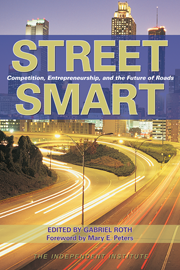President Obama’s recent announcement of a $50 billion “up-front investment” for “renewing and expanding our transportation infrastructure” raises the obvious question: Why should government officials determine the amounts to be spent on roads, railroads, airport runways and air traffic control?
The U.S has a long “user pays” tradition, whereby transportation costs are paid for by users. Why abandon this?
The president proposed expenditures in the following areas:
“Roads: Re-build 150,000 miles of roads.”
It would be nice to have 150,000 miles of well-maintained roads, free of excessive congestion, but the Obama government provides no guidance on how to prioritize the required expenditure.
“Railways: Construct and maintain 4,000 miles of rail—enough to go coast-to-coast.”
Why 4,000? Why not 1,000? Or 10,000? The administration has provided no rationale for spending anything on fixed-rail passenger service, a technology beloved by socialists everywhere for its easier control of trip origins and destinations.
“Runways: Rehabilitate or reconstruct 150 miles of runway.”
Undoubtedly, some airport runways could usefully be improved or lengthened, but why can this not be financed out of user fees or, where runways are congested, by additional landing and take-off charges?
“Air Traffic Control: A robust investment . . . to modernize the nation’s air traffic control system.”
Modernization of air traffic control has been needed for the last 50 years, but plans have taken so long to go through Congress that they were invariably outmoded by the time they were approved.
“Infrastructure Bank: The president proposes to fund a permanent infrastructure bank, which will base its investment decisions on clear analytical measures of performance.”
As existing banks are capable of investing on that basis, one has to assume that the purpose of the infrastructure bank is to fund politically inspired investments that can’t meet conventional banking standards.
Thus, it appears that the items in the president’s list of infrastructure improvements are unspecified, unnecessary or downright wasteful.
When provided by governments, transportation improvements have to compete for funds against other political priorities.
On the other hand, under a market system, consumers themselves determine priorities by their willingness to pay for them. For example, many road users might prefer to spend less on vehicles and more on roads.
It is easy to identify at least two types of expenditures to which transportation users would give high priority:
First is upgrading unsafe facilities.
In 2008, the Department of Transportation categorized 72,868 road bridges as being “structurally deficient.” The National Transportation Safety Board has also questioned the safety of urban rail systems, such as the Washington Metro. Federal grants currently encourage states to extend unsafe systems rather than upgrade them.
Second is the provisioning of new express toll lanes to relieve road congestion in urban areas. Such electronically managed and priced lanes already operate successfully in California, Colorado and Minnesota, and are being built to augment the Washington Beltway.
The above priorities could be implemented by the states themselves, without any federal involvement. Congress could achieve this by declining to re-authorize the federal Highway Trust Fund. The 1956 legislation that established this fund provided for its elimination on completion of the Interstate Highway System and for the cancellation of the relevant federal taxes, of which the fuel taxes are the most important.
In the past, the market provision of roads has been impractical because of the difficulty of obtaining payment for road use. But modern electronics, as used in E-ZPass systems, enable road-use charges to be collected, and paid to road providers, without vehicles having to stop.
Instead of vying with Congress to determine expenditures on transportation infrastructure, the president should encourage Congress to leave these decisions to the states—which could employ market mechanisms to provide the transportation facilities users are prepared to pay for.








